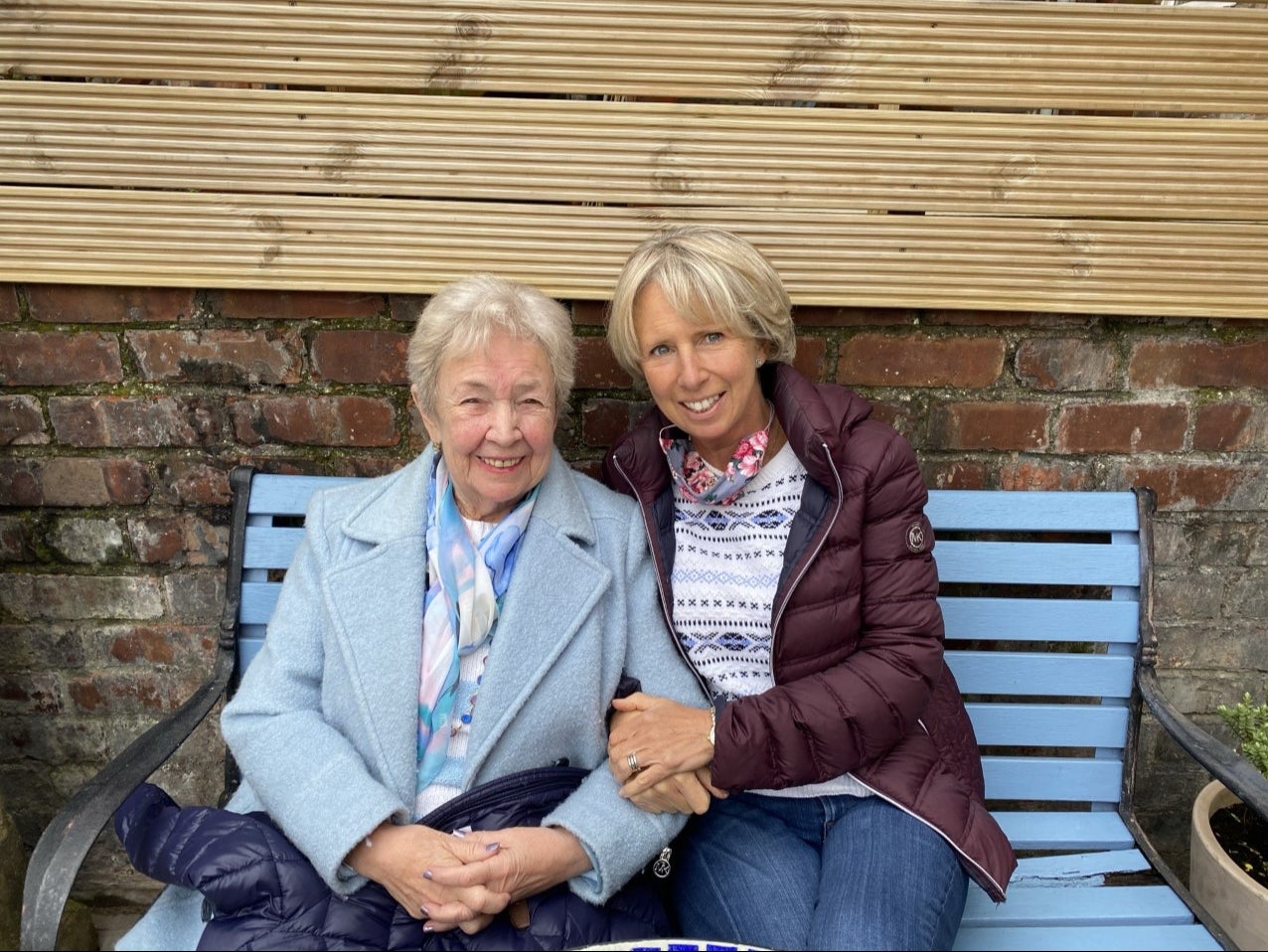‘Isolation is killing people’: Why families of care home residents are not celebrating the end of visitor restrictions
Visitor restrictions in care homes have been relaxed, but relatives and campaigners are not convinced. Kate Ng finds out why reducing isolation is their top priority


It has been more than two years since Imelda Santangeli, 85, has seen most of her family, and she can’t remember what they look like. Having spent the better part of the last two years in isolation, Santangeli’s dementia has accelerated more quickly than expected.
Before Covid-19, Santangeli’s daughter, Nicky Hurst, 59, used to visit her mother every day, taking her out on day trips and to meet other family members. The mother and daughter were always incredibly close, and spent a lot of time together. But, as with everyone who had a relative living in a care home, this came to an abrupt end in March 2020.
For the past year, since she has been allowed to see her mother again, Hurst has tried to assist her deteriorating memory, by taking family photographs with her on visits and updating her on their lives. But nothing can stand in for them being there in person.
“It’s heartbreaking, and everyone in the family feels guilty about not having been able to visit her throughout the pandemic – but it’s never been their fault,” she says.
As the UK entered a nationwide lockdown, care homes across the country shut visitors out in a bid to keep residents safe from the coronavirus. By October 2020, some areas allowed care homes to organise outdoor visits with one person. In March 2021, a year after the first lockdown, care home residents were allowed to nominate one visitor – an essential caregiver – who could regularly visit them inside the property. This increased to three visitors by December that year.
But the biggest change has arrived today, Monday 31 January, with restrictions on visitor numbers lifted completely, allowing entire families to visit their loved ones in care homes for the first time since the pandemic began.
The isolation is barbaric and illogical, and we can’t get anyone to explain why it is necessary that they isolate for so long
For many, this change will feel bittersweet. According to figures from the Office for National Statistics, 173,974 care home residents died between March 2020 and April 2021, with 42,341 involving Covid.
After almost two years of being shut off from the world, care home residents will now have the long-awaited reunion with family members. Isolation, families say, has damaged the lives of many who were left to languish in their rooms or flats in their care homes, unable to understand why their family was absent for so long.
But despite enduring months of separation, today’s rule changes are, for many, not the cause for celebration they had hoped it would be. Families and campaigners are still concerned over the length of time their loved ones have to be isolated in the event of a Covid outbreak in their care homes.
The risk of Mum catching Covid is quite high, but that’s not what I fear – what I fear is the constant, ongoing isolation
“Isolation is what’s killing people. They’ve been forced into these nonsensical isolation periods, they have no idea why their family can’t come to see them, they’re losing their sense of self. It’s just dreadful,” says Hurst.
Under previous rules, care homes were required to go into lockdown for 28 days in the event of a Covid outbreak. This was reduced to 14 days on 8 January 2021, but due to the increased virulence of the omicron variant, care home workers are testing positive so often that it has resulted in care homes locking down for months at a time.
Staff are allowed to return to work after five days of isolation, but the care home must remain in lockdown for the full 14-day period, which campaigners have branded “illogical”. Despite a new change in rules meaning that those receiving care can cut their self-isolation period from 14 days to 10 if they test negative, the official guidance still states that residents should be isolated for 14 days if they are identified as contacts of a positive Covid cases, which are usually staff.
For many families, the risk of Covid entering care homes due to an increase in visitors and it getting locked down over and over again means the reunions are still fraught with anxiety and fear.
“The risk of Mum catching Covid is quite high, but that’s not what I fear – what I fear is the constant, ongoing isolation,” Penny Hutchinson, 53, from Halifax, tells The Independent.

Hutchinson’s mother’s care home has been in rolling lockdowns for months now, which means she is the only person who is allowed to see her as her essential care giver.
The effect of isolation during the first year of the pandemic on Hutchinson’s mother, Yvonne, became especially stark as the year progressed. By the end of 2020, Yvonne, who has dementia, had become “completely non-mobile and non-verbal”.
“She wouldn’t respond to anyone at all, not even us when we called her via FaceTime or on the phone,” Hutchinson says. “It was only when we started being able to visit her again that she started to slowly recover from that state. It’s taken a few months, but now she’s really quite chatty, even if it’s not clear what she’s saying.
“Now she’ll say quite cheerily, ‘Yes?’ when a nurse calls her name. But if these rolling lockdowns continue, I’m really quite afraid she might slip back into the way she was before when she was in isolation for so long.”
The disparity of treatment between care homes residents and the wider population has been staggering
Health secretary Sajid Javid said today’s visitation changes could be made “thanks to the progress” of the vaccine booster programme. Gillian Keegan, minister for care, added: “The changes announced today are backed by scientists, ensuring we all have more freedoms from coronavirus, including care home residents and their families.”
But campaigners say more needs to be done. They are calling for the government to bring the care home isolation period in line with the rest of society. Among the rest of the public, isolation lasts between five to ten days for those who test positive for Covid depending on their vaccine status.
Jenny Morrison, co-founder of Rights for Residents, says that while the change was welcome, the rolling lockdowns have left some residents “cut off from all but one essential caregiver or visitor for months on end”.
She tells The Independent that cutting the isolation period to five days would “end the anomaly that allows care home staff to return to work after five days, while care home residents remain subject to a minimum 14-day isolation period”, resulting in rolling outbreaks and ongoing visiting bans.
“The disparity of treatment between care homes residents and the wider population has been staggering. Once again, the rules on isolation are disproportionate and illogical. Why should residents be denied family contact when care staff are rightly allowed to socialise and return to work after just five days?” she adds.
When contacted by The Independent, a spokesperson for the Department of Health and Social Care pointed to guidance that states residents who test positive for Covid can come out of self-isolation if they test negative for the virus on the fifth and sixth day of a 10-day isolation.
However, care home managers have complained that guidance on lockdown periods when staff test positive has not been provided, throwing further confusion over the situation. Adam Purnell, director of social care at The Institute of Health and Social Care Management, said on Twitter on Monday morning: “No new visiting or admissions guidance published so please explain @GillianKeegan et al why it’s being reported that isolation guidance has changes and visiting has changed for those living in care. You know insurance won’t cover homes without guidance.”
They’ve been forced into these nonsensical isolation periods, they have no idea why their family can’t come to see them, they’re losing their sense of self
For the relatives of care home residents, it is imperative that the government must consult further with relatives of care home residents to take care of their wellbeing. Both Hurst and Hutchinson say that without closer engagement, their loved ones will continue to suffer in isolation.
“From my perspective, the isolation is barbaric and illogical, and we can’t get anyone to explain why it is necessary that they isolate for so long. It feels like the government just wants to be seen as though they are doing something, but it’s not good enough,” says Hurst, who fears that fears further isolation will only exacerbate her mother’s dementia.
Hutchinson is planning to bring her children and husband to see her mother this week, but the family has accepted that Yvonne will likely not remember them.
“She hasn’t seen them in two years. Even with me, she knows I am someone who loves and cares for her, but I don’t think she necessarily knows I’m her daughter,” she says. “She used to be really close to my husband, as he looked after her before the pandemic, and now she probably won’t know who she is. It is a heartbreaking result of the pandemic and these rules – but we’ve moved on now, we just want her to be happy.”
Join our commenting forum
Join thought-provoking conversations, follow other Independent readers and see their replies
Comments
Bookmark popover
Removed from bookmarks